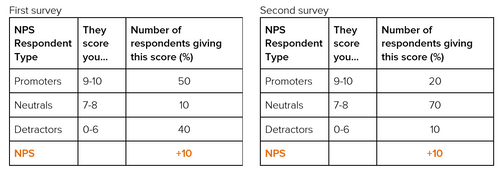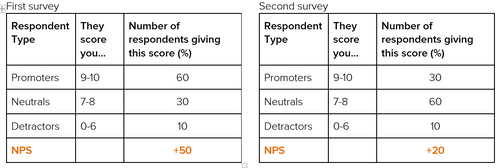How To Get More Out Of Your Net Promoter Score
Let me begin by saying I’m a fan of the Net Promoter Score ® (NPS® ). In fact, a decade ago I packed myself off to London to complete Bain & Co’s intensive Net Promoter Score Accreditation course. But that doesn’t mean I think it can tell you everything you need to know about where you stand with your clients.
So instead of focusing only on the score - and whether it’s ‘good’ or ‘bad’ - I think you need to put your NPS in context. Here are six ways to do just that.
1. TREAT IT AS A CLOSED LOOP
The NPS process should be a closed loop. But I find many firms miss the first step - and final step - in these surveys.
And that first step should always be this: if you’re asking clients to assess your firm and your services, for Pete’s sake, get their permission first. Tell them how the information you’re gathering will be used (preferably for their benefit).
When you’re doing this, do make sure it comes from the client partner, not a third-party provider. Getting someone else to contact them is likely to make your client feel you’re liberal with their data and will set things off on the wrong foot entirely.
When the client has responded, be sure to communicate your gratitude and share what you can with everyone you invited (not just the respondents). Do this step before publicly promoting any score. After all, these are the people that helped you with the inside run.
Make this step count.
Donate to a cause on your client’s behalf or write a personal letter of thanks from the Client Relationship Partner and Managing Partner.
If you’re tracking the clients who give you feedback year in and year out maybe invite them out for a meal or drinks or even reward them with a year off from the survey next time around.
Also, don’t harass anyone. Be clear about how many times you’ll hit your clients with email reminders to complete your survey. Twice after your first request is plenty.
2. SCORE YOUR SCORERS
Not all clients were created equal. Some you want to do your best to keep; others probably cost you more in administrative work and worry than you’ll ever make back from billing. (Just as an aside, you really should be firing those ones, not encouraging them to rate your services.)
So before you look at any individual scores clients have given you - sit down and rate every one of your clients out of 10. This should help you put each score into context rather than taking it at face value.
Consider how profitable each client is, as well as things such as the risk involved in servicing them, how essential they are to the long-term growth of your firm, and how pleasant they are to work with. You should also look at whether they’re new or old; transactional or loyal.
Then, compare what you gave each client to what they gave you.
Ideally, you want some kind of correlation here. If you're scoring perfect 10s from your least profitable, high risk, fee chiselling no-growth clients you have a problem. If they give you a 4/10, well, meh - that’s probably what your score should be.
On the other hand, if your most profitable clients are scoring you at 7/10, I think you have a massive opportunity. You should be focusing on what you can do to better serve them so that you get that score higher still.
Finally, if you get a mediocre score from someone who uses multiple practice groups within your firm, sit down with the professionals from those groups and work out what you can do together to raise the score.
3. DON’T IGNORE THE NEUTRALS
As its name implies, the Net Promoter Score ® gives you a ‘net’ result, reflecting the number of Promoters (9 or more/10) less the number of Detractors (6 or less/10). The problem with this is that it ignores your middle scorers (or the ‘Neutrals’) – those who rated you 7/10 or 8/10.
This means it doesn't necessarily always reflect your true standing or accurately reflect any changes in your performance. For example, consider these two scenarios.
Scenario One (100 respondents)
Here, the Net Promoter Score stays exactly the same (+10) between the two survey intervals, even though there are 30 fewer ‘promoters’ and the mix of responses looks very different.
Scenario Two (100 respondents)
Here, despite the same number of ‘Detractors’, the NPS drops a whopping 30 points from +50 to +20.
But before panic sets in, this scenario may actually not be that bad. Maybe service has dropped a little so that 9/10s became 8/10s. Maybe nothing has changed - it’s just that clients decided 8/10 was a good score this time around. Or maybe the second survey sampled a different set of clients altogether (or different people within each client organisation).
My point here is that to act sensibly on either scenario, more context is needed. Don’t just look at the macro level. Dig into the micro-detail and analyse any changes from individual buyers. This will give you much better intelligence to go off.
4. Look at the score right for you
Another factor you need to think about is what score is actually right for you. You actually don’t want to be anywhere near the perfect +100 because that shows you’re spending too much time on energy on clients you shouldn’t be (see 2. above). Even a score over 50 may be pushing it. You don’t want to be pleasing everyone.
It also pays to remember that different types of clients also score differently. In my experience, the bureaucratic heads of departments in $1BN organisations can be much more generous in their ratings than the battle-scarred founders of private companies with a $100M turnover.
Assessing your scores by job title or client size or specialisation can often tell you a lot more than simply looking at your headline figure.
5. Actions talk louder. Look at whether they actually refer you work
I usually find that when a client assesses you at 10/10 on Net Promoter, they’ve already referred work to you. But many firms don’t record the detail of where their work comes from. This is a huge mistake.
The point of the NPS is that it’s a measure of loyalty in terms of the future likelihood of fees. If you’ve been measuring NPS over three or more years you should have an internal measure of what kind of score leads to referrals (it’s often as low as 7). You should also have some measure of what work gets referred and what the lag is between delighting a client and them having them refer you work.
This kind of information is much more valuable than a simple NPS.
6. Consider who didn’t participate
Just as important as the number of responses you get is the number of responses you don’t get. So keep an eye on how many clients don’t participate. This is an important tell.
If you’ve asked 2,000 clients for feedback and you get 200 responses you may have a statistically significant sample. But I think you should also be concerned that 90% of clients won’t spare the time to say anything about you.
You should be especially worried if the number of clients not responding is increasing each year - they’re obviously telling you something. Perhaps, going back to 1. above, it’s that you should have asked for permissions first.
And finally…
Used well, your NPS can be a great tool for building and expanding a loyal client base. Used poorly, it can be an expensive way of telling you very little you didn’t already know.
WANT MORE?
If you’d like to find out more about how your firm can effectively use the NPS, get in touch.
Further reading & References
How To Turn Around Your Net Promoter Score
What To Do When you Get Patchy Feedback
7 Reasons Professionals Don’t Want to Do Client Feedback
Fred Reichheld (2011) “The Ultimate Question 2.0: How Net Promoter Companies Thrive in a Customer Driven World”, Bain & Company
Rob Markey & Fred Reichheld (2011) “Introducing The Net Promoter System”
Sue-Ella is the Principal of Prodonovich Advisory, a business dedicated to helping professional services firms sharpen their business development practices, and attract and retain good clients.
©Prodonovich Advisory. Please respect our copyright and the effort taken to produce the original material in this article. This article, and any portion of it, may not be reproduced or used in any manner whatsoever without the express written permission of the author.




